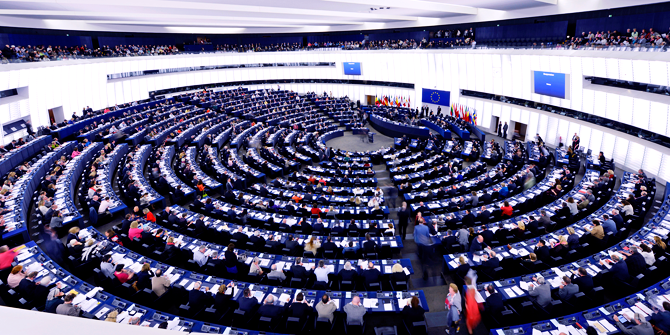
As the UK referendum on EU membership draws closer, final year BSc Government student Tim Rogers outlines the institutions that make up the European Union, and argues that without a basic understanding of how the EU makes laws, it is difficult to make a reasoned judgement about the democratic quality of its practices.
Ahead of the upcoming referendum in the UK on membership of the European Union, the EU’s procedures have repeatedly come under fire from the Leave campaign — as Paul Nuttall of the UK Independent Party (Ukip) puts it in the BBC’s Paxman in Brussels: Who Really Rules Us?, the EU is un-British, and more importantly, un-democratic.
But one thing that is clear in the debate is how little understanding there is of how the EU actually works, and how it makes decisions which affect over 500,000,000 people. Even Jeremy Paxman himself seems to (understandably!) confuse the European Council and the Council of the European Union.
Who’s who: the European Union institutions
There are four key institutions in the EU: the European Council, the Council of the European Union, the European Parliament and the European Commission. Alongside these, there are tens (possibly hundreds) of smaller focused agencies, from the London-based European Medicines Agency to the European Agency for the Management of External Borders, known affectionately as Frontex.
The EU has a ‘bicameral’ legislature — this means that there are two ‘chambers,’ like the House of Commons and House of Lords in Westminster, or the House of Representatives and the Senate in Washington DC. They approve most legislation together.
The European Parliament
The European Parliament (EP) represents the citizens of the European Union, with members (MEPs) from each member state roughly approximate to their share of EU population (about 508 million). EU citizens elect representatives in direct elections, just like in a domestic setting.
The Council of the European Union
The Council of the European Union is the other legislative institution representing the member states of the EU. It sits in different ‘configurations’ depending on the kind of legislation being considered — for example the Economic and Financial Affairs (ECOFIN) Council for law regulating the financial sector, or the Agriculture and Fisheries Council for the regulation of agriculture.
The relevant minister from each member state sits in the Council. For example the UK’s Chancellor of the Exchequer, George Osbourne, currently sits in ECOFIN, whilst the Secretary of State for Environment, Food and Rural Affairs, Liz Truss, sits in the Agriculture and Fisheries Council. As a result, elected national representatives sit in the Council to represent our governments (and vicariously, us), protecting national interests.
The European Council
There is also, bizarrely (given the obvious name clash), the European Council. This is made up of the heads of state or government of member states. The European Council sets the policy agenda of the EU (which guides the European Commission in its work), and appoints important officials (most notably its own President, the President of the European Commission, the Commissioners and the Executive Board of the European Central Bank). It usually takes its decisions by unanimity, preserving the sovereignty of the member states. It represents the ‘high politics’ of the EU, and is responsible for periodic reforms to the EU treaties, most recently the Lisbon Treaty in 2007.
The European Commission
In almost all areas, legislation is proposed and written by the European Commission. The European Commission is the EU’s ‘supranational’ executive (alongside the Council of the European Executive, which acts as a kind of ‘intergovernmental’ executive, since it represents the member states). It represents the interests of the European Union as a whole, yet its officials, the Commissioners, are selected by the member states— for instance, the UK is represented by Lord Hill, Commissioner for Financial Stability, Financial Services and Capital Markets Union. Once appointed, Commissioners no longer represent their member states, but rather work together for the interests of the Union. Appointments to the Commission are confirmed by the European Parliament.
The Commission defines a work plan in response to the European Council’s set priorities, and initiates legislation to meet them. Priorities of the current Juncker Commission include building a ‘Digital Single Market’ and achieving an EU-US trade agreement. The Commission also has important executive tasks alongside its role in initiating legislation, such as monitoring whether member states are complying with EU law, and administering competition law to regulate monopolies.
How decisions are made
Using the so-called Community method, with the Commission initiating legislation and monitoring compliance, the EU institutions provide a means for EU member states to work together efficiently in their mutual interest, making decisions effectively and ensuring that they all follow the rules that they’ve made.
Co-decision
The key to understanding how laws are passed in the European Union is getting to grips with ‘co-decision,’ the ordinary legislative procedure (OLP). Whilst there are other procedures (consultation and cooperation being the two other main ones), as of the Lisbon Treaty, co-decision dominates, and was used for 89% of legislative proposals during the 2009–2014 legislative session.
Under the co-decision, the European Commission, Council of the European Union and European Parliament all have a role to play in passing legislation. The Commission proposes legislation. Neither the European Parliament nor the Council of the European Union can adopt legislation without the consent of the other. There is a navette or ping-pong, a back-and-forth, between the EP and Council as they seek to come to a mutually agreeable version of the Commission’s proposed legislation.
Consent and consultation
Most EU decision-making (including around the Single Market) uses this co-decision method, but other legislative processes are still in use in a small number of areas, for example the ‘consent’ procedure for measures to combat discrimination and the ‘consultation’ procedure in areas of justice and home affairs (e.g. police cooperation).
The legislation procedure
A piece of legislation is proposed by the Commission. It then goes to the European Parliament for a first reading, where it first progresses through a committee, and then to the plenary (i.e. the full chamber), which may make amendments to the proposal. The Parliament decides by simple majority.
Legislation is then passed on for a first reading in the Council of the European Union by the relevant ministers, who are supported by working groups and the Committee of Permanent Representatives (Coreper) below them.
Qualified majority voting
In most areas, the Council makes decisions by ‘qualified majority voting’— this means that a decision only passes if it is approved by 55% of the member states (16/28), representing at least 65% of the EU’s population. Some areas still demand unanimity (i.e. agreement of all the member states) — for example in foreign policy, taxation and how the EU is financed.
Qualified majority voting (QMV) is important to making progress with EU integration and realising the benefits of the EU — it ensures that policy proposals have strong support from governments, but prevents one or a minority of states from slowing down integration (e.g. when moving to complete the Single Market in the 1990s) by vetoing proposals. It means member states share their sovereignty. As Article 1 of the Treaty of European Union puts it, “the Member States conference competences [to the EU] to attain objectives they have in common.”
Council position and second reading
The Council may approve the legislative act (with any EP amendments), or it may adopt its own further amendments, forming the ‘Council position.’
Now the legislation is returned to the European Parliament for a second reading. It may accept the Council position, adopting the act. It may make further amendments to the Council position, and send them to a second reading in the Council. As a last resort, it may reject the Council position, meaning the act is not adopted. This leaves the Commission free to make a new proposal.
Alongside the EP’s amendments at the second reading, the Council receives the Commission’s opinions on the amendments that the EP proposed for its own second reading. The Council may approve the EP amendments — unanimously if the Commission gave a negative opinion on what came from the EP, and by qualified majority if a positive opinion was given.
Conciliation committee or early agreement
If the Council cannot accept the EP’s position, a ‘conciliation committee’ is convened. Here, the Council and European Parliament come together to try to agree a joint text. If they agree on a common position and it is adopted by the EP and Council, the legislation is adopted. If they fail to agree a joint text or it is rejected by either the Council or EP, the act is not adopted.
For many pieces of legislation today, this back-and-forth is avoided through ‘early agreement’ — here, the Commission, Council and EP meet informally in a so-called “trilogue” to come to a common position ahead of the first readings.
A collaborative approach
Without a basic understanding of how the EU makes laws, it is difficult to make a reasoned judgement about the democratic quality of its practices. In this piece, we have seen how the institutions of the European Union come together to make legislation; taking into account the interests of the Union as a whole through the Commission; the wishes of the citizens through the Parliament; and the preferences of member states’ governments through the European Council and Council of the European Union.
In this way, the institutions of the EU are collaborative. They work together in policy areas agreed unanimously by member states (via treaties) to advance the common interests of member states and their citizens. As a result, although this cooperative process is complex, it seems far less un-British, and even far less un-democratic, than the Leave campaign suggests.
Tim Rogers is a third year undergraduate on the BSc in Government in the Department of Government. For more information on our undergraduate programmes, please visit the Department of Government website.
Note: This article gives the views of the author, and not the position of the Department of Government blog, nor of the London School of Economics.






